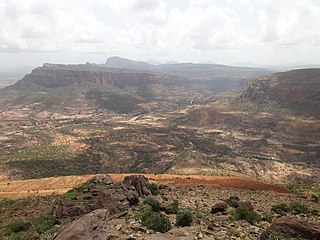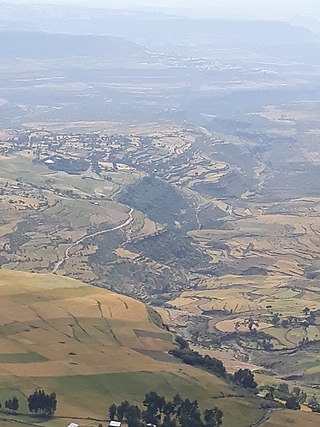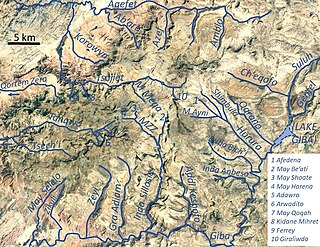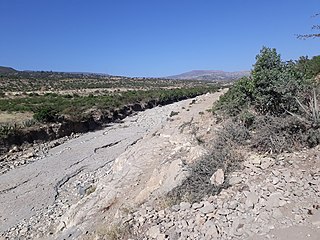Tsigereda is the capital of Gere-alta woreda. Tsigereda means "rose" in the local Tigrinya language.

The soils of the Sa'isi Tsa'ida Imba woreda (district) in Tigray (Ethiopia) reflect its longstanding agricultural history, highly seasonal rainfall regime, relatively low temperatures, overall dominance of metamorphic and sandstone lithology and steep slopes.
The soils of the Inderta woreda (district) in Tigray (Ethiopia) reflect its longstanding agricultural history, highly seasonal rainfall regime, relatively low temperatures, overall dominance of limestone and dolerite lithologies and steep slopes. Outstanding features in the soilscape are wide plains with Vertisols.

The soils of the Kola Tembien woreda (district) in Tigray (Ethiopia) reflect its longstanding agricultural history, highly seasonal rainfall regime, relatively high temperatures, overall dominance of sandstone and metamorphic lithology and steep slopes.

The soils of the Dogu’a Tembien woreda (district) in Tigray (Ethiopia) reflect its longstanding agricultural history, highly seasonal rainfall regime, relatively low temperatures, an extremely great variety in lithology and steep slopes. Outstanding features in the soilscape are the fertile highland Vertisols and Phaeozems in forests.

The Ab’aro is a river of the Nile basin. Rising in the mountains of Dogu’a Tembien in northern Ethiopia, it flows northwestward to empty into the Weri’i, which is a tributary of Tekezé River.

The Zeyi is a river of the Nile basin. Rising in the mountains of Dogu’a Tembien in northern Ethiopia, it flows southward to empty in Giba and Tekezé River.

The Korowya is a river of the Nile basin. Rising in the mountains of Dogu’a Tembien in northern Ethiopia, it flows westward to empty finally in the Weri’i and Tekezé River.

The Agefet is a river of the Nile basin. Rising in the mountains of Gheralta in northern Ethiopia, it flows westward to empty finally in the Weri’i which itself discharges into Tekezé River.

The May Zegzeg is a river of the Nile basin. Rising in the mountains of Dogu’a Tembien in northern Ethiopia, it flows southward to empty finally in the Giba and Tekezé River.

The Azef is a river in the Nile basin. Rising in the mountains of Dogu’a Tembien in northern Ethiopia, it flows northward to empty finally into the Weri’i which in turn discharges into Tekezé River.

The Amblo is a river of the Nile basin. Rising in the mountains of Dogu’a Tembien in northern Ethiopia, it flows northward to empty finally in the Weri’i and Tekezé River.

The Tsech'i is a river of the Nile basin. Rising in the mountains of Dogu’a Tembien in northern Ethiopia, it flows westward to empty finally in Giba and Tekezé River.

The May Selelo is a river of the Nile basin. Rising in the mountains of Dogu’a Tembien in northern Ethiopia, it flows southward to empty in the Giba and Tekezé River.

The Zikuli, also called Gereb Awhi or Mennewe River, is a river of the Nile basin. Rising in the mountains of Dogu’a Tembien in northern Ethiopia, it flows southward to empty finally in the Giba and Tekezé River.

The May Sho’ate is a river of the Nile basin. Rising in the mountains of Dogu’a Tembien in northern Ethiopia, it flows southward to empty finally in Giba and Tekezé River.

The Addi Keshofo is a river of the Nile basin. Rising in the mountains of Dogu’a Tembien in Northern Ethiopia, it flows southwards to empty directly in the Giba and further in Tekezé River.

The Ruba Bich’i is a river of the Nile basin. Rising in the mountains of Dogu’a Tembien in northern Ethiopia, it flows southeastward to empty directly in the Giba and further in Tekezé River.

The Hurura is a river of the Nile basin. Rising in the mountains of Dogu’a Tembien in northern Ethiopia, it flows southwestward to empty in Giba and finally in Tekezé River.

The Ch’eqofo is a river of the Nile basin. Rising in the mountains of Dogu’a Tembien in northern Ethiopia, it flows southwestward to empty finally in the Giba and Tekezé River.

















